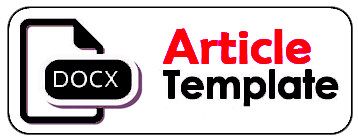Author Guidlines
Author Guidelines Authors submitting manuscripts must adhere to the provided author guidelines and use the designated template. Submissions that do not follow these guidelines or are formatted differently will be rejected by the editorial team prior to the review process. Only manuscripts that strictly follow the required formatting available for download in the Template and Author Guidelines will be considered. The template is intended to help authors format their work correctly, as it mirrors the exact layout expected by the editors. To use the template, simply save the MS Word file and paste your content into it. All manuscripts must be written in English.
Paper Format
1. Manuscripts must be in English. It should be typed in MS Word doc. format; using 12-pt Times New Roman font; left, right, top, and bottom margins are 3 cm; 1.5 spaced on A4-sized paper; length: between 4,000 and 8,000 words (including abstract, references, and footnotes).
2. The article structure contains (a) Title; (b) Author(s) name, affiliation, and email address of the corresponding author; (c) Abstract; (d) Keywords; (e) Introduction; (f) Method; (g) Findings and Discussion; (h) Conclusion; (i) References, and (n) Appendices (if any).
3. The citations and references should follow the style of the Chicago Manual of Style 17th Edition (full note) and use Reference Management Software such as Mendeley (https://www.mendeley.com).
4. The manuscript must be checked in terms of grammar, structure, spelling, etc. It is suggested to use Grammar Checker Software Grammarly (http://app.grammarly.com).
5. The manuscript must be submitted through the OJS (Lex Scientia Website).
Title
The paper title should indicate the novelty of the research. It should be concise and informative. It does not contain infrequently-used abbreviations. The main idea should be first written and followed by its explanation. Use bold for your article title, with an initial capital letter for proper nouns with 12-pt Times New Roman Bold.
Author(s) name, affiliation, and email address of the corresponding author
The author's name, affiliation, and email address of the corresponding author written in the paper, also in the user profile on the journal website. The corresponding author will handle correspondence at all stages of refereeing and publication, also post-publication; this responsibility includes answering any future queries about the Methodology and Materials of the paper. Ensure that the e-mail address is given and that contact details are kept up to date by the Corresponding Author.
Abstract
Please write your paper's abstract in a single paragraph using Italic font, 12pt Times New Roman, and single spacing. The abstract should be no longer than 250 words. It is not meant to serve as an introduction or a conclusion. Instead, it should be a concise summary that includes the research problem, methodology, key scientific findings, and a brief conclusion. If there are other significant elements discussed in the paper that contribute to the overall results, they may also be included—while keeping in mind the word limit of the abstract.
Keywords
Provide 3 to 5 specific and truly conceptual keywords either single words or short phrases that precisely reflect the core concepts of your manuscript. Avoid overly general terms. Keywords serve as essential identifiers for indexing and search purposes, so they must be carefully chosen to accurately represent your topic and help readers find your article. Only use abbreviations that are widely recognized in your field. Separate each keyword or phrase with a semicolon (;).
Introduction
The introduction section, comprising approximately 15–20% of the total manuscript length, must clearly articulate the purpose of the study. It should provide the background of the issue, a state-of-the-art review, and cite at least five relevant articles from reputable international or accredited journals published within the last ten years. The introduction must also include a gap analysis in relation to prior studies, highlight the novelty of the research, and clearly present the research objectives. This entire section should be written in paragraph form, not as bullet points or lists.
Method
The methodology section, which should make up about 10–15% of the total article length, must include a detailed explanation of the research type, research approach, sources of data and legal materials, as well as the methods used for data analysis.
Findings and Discussion
This section should present a clear explanation of the research findings by addressing what was discovered and how it was analyzed. It should also explore the relevance of these findings in relation to existing concepts or theories, explaining why they matter. Additionally, the discussion must include a critical comparison with previous studies, highlighting whether the current results support, refine, or challenge earlier research (what else is contributed).
Conclusion
Answer the research objectives and collect new findings supported by sufficient research data, accurately and in-depth (only one paragraph).
References
All sources cited within the main text must also be listed in the References section, and every entry in the References must be cited in the body of the article. References should be current, ideally published within the past 10 years. The primary references should consist of journal articles, conference proceedings, and research-based documents such as theses or dissertations that are accessible online (include a permalink or DOI). At least 80% of all cited sources must be journal articles. The References list must be organized alphabetically and chronologically, formatted in 12-point Times New Roman, justified, with single spacing and a hanging indent. Ensure that each reference is accurately checked against the original source for correct details such as author names, volume, issue, year, and permalink/DOI. It is strongly recommended to use reference management tools like Mendeley (https://www.mendeley.com) to organize citations. Refer to previously published articles in the same journal as formatting examples.





